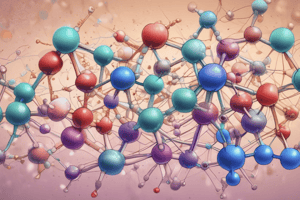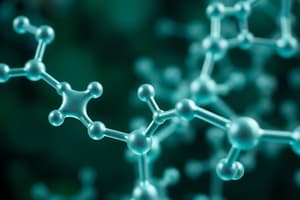Podcast
Questions and Answers
What is the abbreviation for Glycine?
What is the abbreviation for Glycine?
- Val, V
- Ala, A
- Gly, G (correct)
- Pro, P
What type of amino acid is Glycine?
What type of amino acid is Glycine?
Small, Aliphatic, Non-polar
Which amino acid has a ring as the R-group?
Which amino acid has a ring as the R-group?
- Glutamate
- Tryptophan
- Phenylalanine (correct)
- Alanine
How many carbon atoms are there in Valine?
How many carbon atoms are there in Valine?
What is unique about the structure of Proline?
What is unique about the structure of Proline?
Which of the following amino acids is positively charged at physiologic pH?
Which of the following amino acids is positively charged at physiologic pH?
What is the functional group present in Aspartate?
What is the functional group present in Aspartate?
Which amino acid is the first added during translation?
Which amino acid is the first added during translation?
Isoleucine has the same number of carbons as Leucine.
Isoleucine has the same number of carbons as Leucine.
What type of amino acid is Tyrosine?
What type of amino acid is Tyrosine?
Which amino acid has an imidazole ring?
Which amino acid has an imidazole ring?
What type of bond can cysteine form?
What type of bond can cysteine form?
Flashcards
Glycine (Gly, G)
Glycine (Gly, G)
The smallest amino acid, with a simple structure and no chiral center. It is often found in tight turns in peptide chains due to its small size.
Alanine (Ala, A)
Alanine (Ala, A)
An amino acid with a simple methyl group attached to its carbon backbone. It is non-polar but does not exhibit hydrophobic properties.
Valine (Val, V)
Valine (Val, V)
A branched-chain amino acid with two methyl groups close to the peptide backbone, giving it a distinctive 'V' shape. Its bulkiness makes it hydrophobic.
Leucine (Leu, L)
Leucine (Leu, L)
Signup and view all the flashcards
Isoleucine (Ile, I)
Isoleucine (Ile, I)
Signup and view all the flashcards
Phenylalanine (Phe, F)
Phenylalanine (Phe, F)
Signup and view all the flashcards
Tryptophan (Trp, W)
Tryptophan (Trp, W)
Signup and view all the flashcards
Tyrosine (Tyr, Y)
Tyrosine (Tyr, Y)
Signup and view all the flashcards
Histidine (His, H)
Histidine (His, H)
Signup and view all the flashcards
Lysine (Lys, K)
Lysine (Lys, K)
Signup and view all the flashcards
Arginine (Arg, R)
Arginine (Arg, R)
Signup and view all the flashcards
Aspartate (Asp, D)
Aspartate (Asp, D)
Signup and view all the flashcards
Study Notes
Amino Acids Overview
- Glycine (Gly, G): Smallest amino acid, achiral; important for fitting into tight turns in peptide chains without affecting hydrogen bonding with water.
- Alanine (Ala, A): Comprises three carbons with a simple methyl group; does not exhibit hydrophobic properties despite being non-polar.
- Valine (Val, V): Branched and bulky, hydrophobic with a distinctive "V" shape due to two methyl groups close to the peptide backbone.
- Leucine (Leu, L): Similar to valine but with one additional carbon; branched at the gamma-carbon, contributing to its hydrophobic nature.
- Isoleucine (Ile, I): Shares the same carbon count as leucine but with a unique methyl group distribution at the beta and gamma positions.
Aromatic Amino Acids
- Phenylalanine (Phe, F): Contains an aromatic ring, making it hydrophobic similar to alanine but with increased complexity in structure.
- Tryptophan (Trp, W): Features two aromatic rings; less hydrophobic than phenylalanine and includes an indole group, impacting its function in proteins.
- Tyrosine (Tyr, Y): Possesses both hydrophobic and hydrophilic properties based on location within proteins, also contains a hydroxyl (-OH) group influencing its interactions.
Polar Amino Acids and Their Characteristics
- Histidine (His, H): Contains an imidazole ring with two nitrogen atoms, capable of acting as a base due to protonation under physiological conditions.
- Lysine (Lys, K): Basic amino acid that gains a positive charge at physiological pH; functions similarly to histidine in terms of proton acceptance.
- Arginine (Arg, R): Basic and positively charged at physiological pH due to a guanidinium group; classified with histidine and lysine as key basic amino acids.
Acidic Amino Acids
- Aspartate (Asp, D): Acts as an acid, carrying a negative charge at physiological pH; functions as the conjugate base of aspartic acid, containing a four-carbon structure.
- Glutamate (Glu, E): Similar to aspartate but possesses five carbons; acts as an acid and negatively charged under physiological conditions, serving as the conjugate base of glutamic acid.
Additional Amino Acids
- Asparagine (Asn, N): Polar amino acid functioning as an amide derivative of aspartate; includes a reactive sulfhydryl group, contributing to disulfide bond formation.
- Methionine (Met, M): Non-polar amino acid with a thioether linkage; serves as the first amino acid introduced during the protein translation process.
- Proline (Pro, P): Distinguished by its imino acid structure, causing kinks in peptide backbones; facilitates structural changes due to its unique bonding involving the alpha-amino group.
Studying That Suits You
Use AI to generate personalized quizzes and flashcards to suit your learning preferences.




